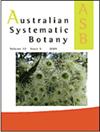The Wendlands of Herrenhausen Gardens (Hanover, Germany): a study of their Australian plant specimens in the herbarium of the University of Goettingen (GOET)
IF 1.6
3区 生物学
Q4 EVOLUTIONARY BIOLOGY
引用次数: 2
Abstract
Between 1778 and 1903, three successive generations of the Wendland family were Court Gardeners at the Royal Gardens of Herrenhausen, Hanover, Germany. In addition to their horticultural responsibilities, they published several important taxonomic accounts, some involving Australian plants. Johann Christoph Wendland (1755–1828) (J.C.Wendl.) established the endemic Australian genera Angianthus J.C.Wendl. (Asteraceae), Hakea Schrad. & J.C.Wendl. (Proteaceae) and Waitzia J.C.Wendl. (Asteraceae), and provided novel work on Melaleuca L. (Myrtaceae) and Acacia Mill. (as Mimosa L; Fabaceae); Heinrich Ludolph Wendland (1792–1869) (H. L.Wendl.) provided novel and revisionary work on Acacia and Leptospermum J.R.Forst. & G.Forst. (Myrtaceae); and Hermann Wendland (1825–1903) (H. Wendl.) specialised in the palms (Arecaceae) and wrote Palmae Australasicae with Oscar Drude, the foundational work on Australian palms. A search of all the databases and other references accessible to us has resulted in the identification of ~148 names of Australian plants in which the author citation includes any of the three Wendlands. Of these, ~30 are the currently accepted names. Lectotypes are here proposed for the names Acacia amoena H.L.Wendl., A. crassiuscula H.L.Wendl., A. dolabriformis H.L.Wendl., A. emarginata H.L.Wendl., A. homomalla H.L.Wendl., Aster tomentosus J.C.Wendl., Leptospermum buxifolium H.L.Wendl., L. emarginatum H.L.Wendl. ex Link, L. glomeratum H.L.Wendl., Melaleuca linearis Schrad. & J.C.Wendl., M. thea Schrad. & J.C.Wendl., Passiflora glabra J.C.Wendl., Protea nectarina J.C.Wendl., P. pulchella Schrad. & J.C.Wendl., Pultenaea daphnoides J.C.Wendl., P. linophylla Schrad. & J.C.Wendl., P. retorta J.C.Wendl. and Tristania subverticillata H.L.Wendl. Figures are provided of all the proposed lectotypes housed in GOET.德国汉诺威Herrenhausen花园的温德兰:哥廷根大学植物标本馆中澳大利亚植物标本的研究
从1778年到1903年,文德兰家族连续三代都是德国汉诺威赫伦豪森皇家花园的宫廷园丁。除了他们的园艺职责外,他们还发表了几篇重要的分类学论文,其中一些涉及澳大利亚的植物。Johann Christoph Wendland (1755-1828) (J.C.Wendl.)建立了澳大利亚特有的Angianthus wendl属。(菊科),Hakea Schrad。& J.C.Wendl。(Proteaceae)和Waitzia J.C.Wendl。(菊科),并提供了关于千层木(桃金娘科)和金合欢的新工作。(如含羞草L;豆科);Heinrich Ludolph Wendland (1792-1869) (H. L.Wendl.)提供了关于金合欢和细尾草的新颖和修订工作。& G.Forst。(桃金娘科);Hermann Wendland (1825-1903) (H. Wendl.)专门研究棕榈(槟榔科),并与Oscar Drude合著了关于澳大利亚棕榈的基础著作《澳大利亚棕榈》。通过对所有数据库和其他可获得的参考文献的检索,我们发现了大约148种澳大利亚植物的名称,其中作者引用的文献中包含了三种温德兰中的任何一种。其中,约有30个是目前公认的名称。在这里,我们提出了合欢树(Acacia amoena h.l.m endl)名称的选型。A.带骨动物h . l.温德尔;, A. dolabriformis H.L.Wendl。温德尔(H.L.Wendl);, A. homomalla . H.L.Wendl。,《阿斯特·毛毛》j.c.温德尔。;细尾草;温德尔。ex Link, L. glomeratum H.L.Wendl。,千层线性是施拉德。& J.C.Wendl。西娅·施拉德先生。& J.C.Wendl。西番莲,j.c.m endl。温德尔。P. pulchella Schrad。& J.C.Wendl。;;;;;,亚麻荠。& J.C.Wendl。j . c .温德尔。和颠覆性崔斯塔尼亚。提供了GOET中所有拟议的型号的数字。
本文章由计算机程序翻译,如有差异,请以英文原文为准。
求助全文
约1分钟内获得全文
求助全文
来源期刊

Australian Systematic Botany
生物-进化生物学
CiteScore
3.10
自引率
12.50%
发文量
12
审稿时长
>12 weeks
期刊介绍:
Australian Systematic Botany is an international journal devoted to the systematics, taxonomy, and related aspects of biogeography and evolution of all algae, fungi and plants, including fossils. Descriptive taxonomic papers should normally constitute a comprehensive treatment of a group. Short papers on individual species and nomenclatural papers must contain significant new information of broader interest to be considered. The prestigious L.A.S. Johnson Review Series is published. Other review articles will also be considered. All papers are peer reviewed.
Australian Systematic Botany is published with the endorsement of the Commonwealth Scientific and Industrial Research Organisation (CSIRO) and the Australian Academy of Science.
 求助内容:
求助内容: 应助结果提醒方式:
应助结果提醒方式:


